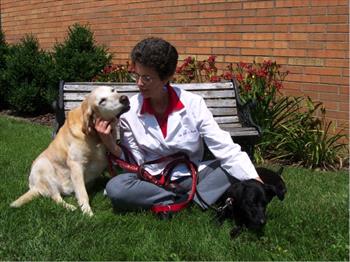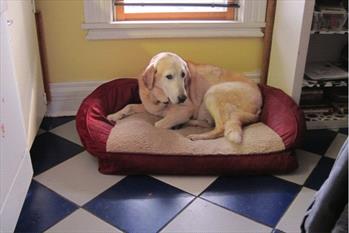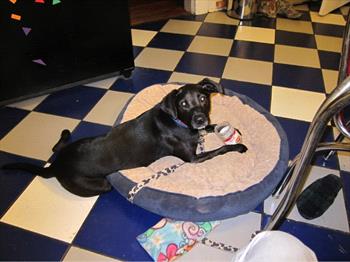At my veterinary practice, Okaw Veterinary Clinic Tuscola Il, I see both general care and behavior problems. Often I see the joy, frustrations, and enrichment a new dog can bring into the home of an established dog. Advice abounds through the internet, friends, family, and shelter workers on how to add a new buddy to your home. Some of the advice helps, and yet there can be trouble that one did not expect. As a veterinarian trained in animal behavior and health, I will address the best way to add a new buddy dog. Whether it is adding a lifelong friend to your family, or to welcome a visiting dog at the holidays with peace and harmony. The points I cover will apply to your siblings’ beloved pooch visiting at Christmas, as well as if you’re considering adding a lifelong friend to your family. There are 3 main points to consider:
Point 1:
First, understand your established dog’s home and life. This dog has an established place in the hierarchy in the home – eating, attention, going through the door, availability of toys, etc. All of these elements are resources. In a solo dog home, all resources are this dog’s. That dog is always number one. Generally, dogs do not share well. As one veterinary behaviorist stated “Humans are the only species that wants to sit and eat together at the same time. Other species take their food and go to a private place to eat without any sharing or competition”. You do not see dogs bringing their food or toys to form a circle to talk about the day as they eat or chew. In the dog world, what is mine is mine and what is yours can be mine too. When there is not clear control of these resources by the humans, then the dogs are open to compete for them. That is when trouble can erupt. I cannot count the number of housemate or visiting dogs suddenly fighting over food or toys that result in emergency visits. This is the holiday nightmare – your brother’s beloved Yorkie is chomped on by your Golden Retriever when the little dog went to the food dish. It is this innate competition between the dogs that leads to trouble. Thus, the most important element for a harmonious home when adding any dog is to completely separate all feeding.
Point 2:
Second to that, and just as important, is do not allow any overtaking of any beds, toys, attention time, or going through doorways. How do you control the dogs? Keep a lightweight leash attached to both dog’s collars to intervene early and often. This dragline allows you to quickly pull the pestering dog away, tether them and reward as you do this. I call this positive tethering – rewards for moving away and staying put on tether. The dragline is an easy tool for safe intervention. It is comfortable for the dogs and prevents grabbing collars and more agitation.
Additionally, follow Dr. Sophia Yin’s Learn To Earn Program, as well as the Learn To Earn Program Implementation Guide, with the new dog, no matter what that dog’s age. The Learn to Earn Program helps owners develop a better ability to provide guidance and leadership, and helps dogs learn impulse control. This program is the best way to establish polite manners from the dogs. If everyone followed this plan, emergency calls around holidays and post adoption would drop tremendously. If you or any family members are having a hard time understanding why this is so important, here is an analogy that hit home with me. Pretend your parents decide to bring home a foster child, but you don’t know that until the foster child arrives. When this child sits in your chair, eats off your plate as you eat, wears your clothes and sleeps in your bed, you get upset. The resources have been limited and you feel demoted in rank. You may not act out at first, but tensions arise until the parents establish rules. Increasing resources, with rules enforced regarding who gets what when, decreases conflict. You need to know what you get, when you get it and in what order. Our dogs need the same.
One must also consider the health and age of both the established dog, and the dog coming into the home as we make this mix. If you have an older dog, you may not be aware of the mild to moderate stiffness and decreased abilities of this dog. Many dogs over 50 lbs. and over 7 years of age are experiencing mild back pain or decreased flexibility, making it more difficult to rise, move quickly, or watch out for another dog. Vision declines at about age 10. Hearing also declines at this age. If your established dog ever had any trauma that too can be affecting them. That slower gait, or lack of agility may not have been evident to you when it was the solo dog in the household. Now you add a young active dog, and the older dog may be growling, avoiding the living area or even snapping at you. Why? Low-level chronic pain is causing this dog to guard their body from touch. The dog is using aggression to prevent the young dog or you from making them move much because it hurts! The loveable Labrador may now snap at you as you are pulling on the collar to make them get up to go out. That dog did not turn mean – that dog is in pain. Dogs do not limp, or cry in pain until they are at a high level of pain. Avoiding the family area, hesitating at the stairs, not getting up as often – these are signs of pain in an older dog. So, if your established dog is over 7, have a complete check up including an orthopedic exam by your veterinarian. Discuss your older dog’s health needs before you add a new dog to the family.
Controlling resources also helps to decrease anxiety in your established dog. This in turn also helps to reduce pain. How? Separate feeding allows you to know exactly how well your older dog is eating, accommodate special diets, and prevent accidental ingestion of medication added to the food – I had a case where a young giant breed dog came into my office staggering, acting disoriented and drunk. On exam I asked about toxins, seizure, trauma. None of that was possible. I considered whether he had an older housemate dog, and if that dog was on medication, so I asked. Yes, there was an older dog, and, yes, she mixed medication into the older dog’s food. The younger dog often “cleaned up” after the older dog so it ingested some medication in the leftover food. I gave the dog fluids and within 12 hours all of the symptoms resolved. Initially, I was concerned about major spinal cord disease or other problems that would have required extensive testing. Luckily, this case ended well, which taught me to emphasize to all owners the importance of completely separate feeding, especially in homes with older dogs or dogs on medication.
Point 3:
Third, consider the age and needs of a new dog and whether you can accommodate that. I am speaking specifically to bringing a cute puppy into a household with an adult dog. The adult dog may mentor this pup – show it how to go out the doggie door, where to potty, how to be calm at times, which would be great. Yet, lots of owners forget how much activity and attention that puppy needs. As a result this puppy could develop naughty behaviors or worse, a playful puppy getting too physical with the older dog, making aches and pains worse. Often I hear clients say, “Why doesn’t the old dog just bite the pup to teach him a lesson? ”. That may resolve some of these behaviors, but it may also escalate into fighting. Engaging in a fight takes energy, movement and agility, which an older dog may not have. The puppy does not learn to be more controlled and polite, resulting in learning rough play and ultimately aggression. This is harmful for both the pup and the older dog. The pup is not learning good manners in this “natural way”, and the older dog is subjected to chronic pain. If you get a puppy, you have to devote time to training, exercise and home manners so that puppy can smoothly fit into your family. Remember, a puppy is not really an adult until they’re about 3 years old. Be realistic about your ability to commit time and focus to socialization and energy needs.
How bad could it be if you don’t bother with all of this control and consideration for each dog’s needs? Ask any emergency veterinary clinic how many lacerations, deep, fatal puncture wounds, or severe eye injuries sustained in housedog fights that happen in a month. The worst is a euthanasia call because the human has been bitten breaking up a fight. Sad to say, there are many such incidents. I have been in the place of having to administer emergency care to the victim of a housemate dogfight, unaware of what problems were going on in the home. Sometimes, families just felt the growling, snarling, and lunging were not a problem until a bite happened. Then, it was too intense to tolerate any longer. They did not understand that aggression was building up. In just about every case of severe injury, it was food, a toy, a bed, or going through the door that instigated the fight. However, the fight had been brewing for months before, unnoticed. In fact, the victim dog may have been as much, if not more, of a culprit in the resulting fight that caused the tragedy. It is extremely difficult to address this when emotions are high seeing your dog with a severe injury caused by your other dog. I often address in-home aggression later, when emotions have calmed down.
Additionally, not only do we have to address aggression, but also if these two dogs can live together. They’ve developed deep tensions and understand they bite to resolve issues. As they say, “Don’t go there”. Control the resources of your dogs, according to the rank that you have determined and be consistent. That will keep a safe and happy dog home.





